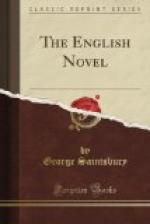There is no doubt that one main attraction of this letter-plan (whether consciously experienced or not does not matter) was its ready adaptation to Richardson’s own special and peculiar gift of minute analysis of mood, temper, and motive. The diary avowedly, and the letter in reality, even though it may be addressed to somebody else, is a continuous soliloquy: and the novelist can use it with a frequency and to a length which would be intolerable and impossible on the stage. Now soliloquy is the great engine for self—revelation and analysis. It is of course to a great extent in consequence of this analysis that Richardson owes his pride of place in the general judgment. It is quite possible to lay too much stress on it, as distinguishing the novel from the romance: and the present writer is of opinion that too much stress has actually been laid. The real difference between romance per se and novel per se (so far as they are capable of distinct existence) is that the romance depends more on incident and the novel more on character. Now this minute analysis and exhibition, though it is one way of drawing or constructing character, is not the only, nor even a necessary, one. It can be done without: but it has impressed the vulgar, and even some who are not the vulgar, from Dr. Johnson to persons whom it is unnecessary to mention. They cannot believe that there is “no deception”—that the time is correctly told—unless the works of the watch are bared to them: and this Richardson most undoubtedly does. Even in his ’prentice work, every flutter of Pamela’s little heart is registered, and registered probably enough: nor could the registry have been effected, perhaps, in any other way that should be in the least probable so well as by the letter and journal method. Of course this analysis was not quite new; it had existed in a sort of way in the heroic novel: and it had been eminently present in the famous Princesse de Cleves of Madame de la Fayette as well as in her French successors. But these stories had generally been as short as the heroics had been long: and no one had risen (or descended) to anything like the minuteness and fullness of Richardson. As was before pointed out in regard to the letter-system generally, this method of treatment is exposed to special dangers, particularly those of verbosity and “overdoing”—not to mention the greater one of missing the mark. Richardson can hardly be charged with error, though he may be with excess, in regard to Pamela herself in the earlier part of the book—perhaps even not in regard to Mr. B.’s intricacies of courtship, matrimonial compliment, and arbitrary temper later. But he certainly succumbs to them in the long and monstrous scene in which Lady Davers bullies, storms at, and positively assaults her unfortunate sister-in-law before she is forced to allow that she is her sister-in-law. Part of course of his error here comes from the mistake with which Lady




